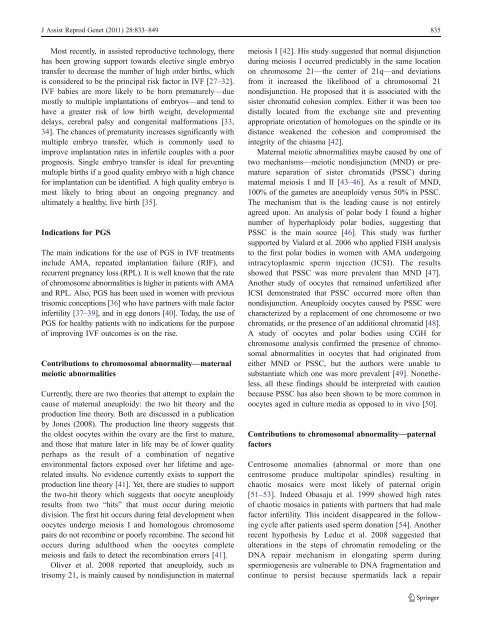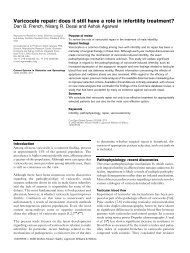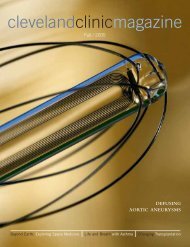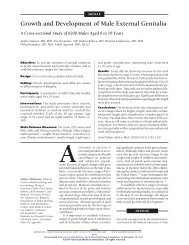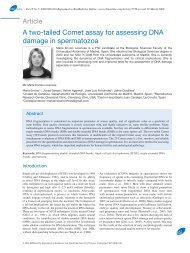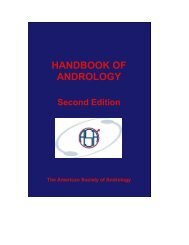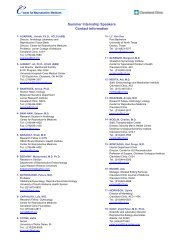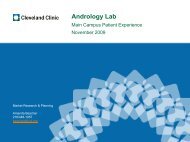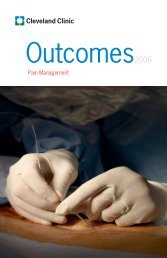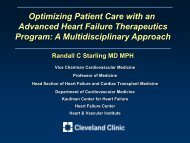Preimplantation genetic screening: does it help or ... - ResearchGate
Preimplantation genetic screening: does it help or ... - ResearchGate
Preimplantation genetic screening: does it help or ... - ResearchGate
You also want an ePaper? Increase the reach of your titles
YUMPU automatically turns print PDFs into web optimized ePapers that Google loves.
J Assist Reprod Genet (2011) 28:833–849 835<br />
Most recently, in assisted reproductive technology, there<br />
has been growing supp<strong>or</strong>t towards elective single embryo<br />
transfer to decrease the number of high <strong>or</strong>der births, which<br />
is considered to be the principal risk fact<strong>or</strong> in IVF [27–32].<br />
IVF babies are m<strong>or</strong>e likely to be b<strong>or</strong>n prematurely—due<br />
mostly to multiple implantations of embryos—and tend to<br />
have a greater risk of low birth weight, developmental<br />
delays, cerebral palsy and congen<strong>it</strong>al malf<strong>or</strong>mations [33,<br />
34]. The chances of prematur<strong>it</strong>y increases significantly w<strong>it</strong>h<br />
multiple embryo transfer, which is commonly used to<br />
improve implantation rates in infertile couples w<strong>it</strong>h a po<strong>or</strong><br />
prognosis. Single embryo transfer is ideal f<strong>or</strong> preventing<br />
multiple births if a good qual<strong>it</strong>y embryo w<strong>it</strong>h a high chance<br />
f<strong>or</strong> implantation can be identified. A high qual<strong>it</strong>y embryo is<br />
most likely to bring about an ongoing pregnancy and<br />
ultimately a healthy, live birth [35].<br />
Indications f<strong>or</strong> PGS<br />
The main indications f<strong>or</strong> the use of PGS in IVF treatments<br />
include AMA, repeated implantation failure (RIF), and<br />
recurrent pregnancy loss (RPL). It is well known that the rate<br />
of chromosome abn<strong>or</strong>mal<strong>it</strong>ies is higher in patients w<strong>it</strong>h AMA<br />
and RPL. Also, PGS has been used in women w<strong>it</strong>h previous<br />
trisomic conceptions [36] who have partners w<strong>it</strong>h male fact<strong>or</strong><br />
infertil<strong>it</strong>y [37–39], and in egg don<strong>or</strong>s [40]. Today, the use of<br />
PGS f<strong>or</strong> healthy patients w<strong>it</strong>h no indications f<strong>or</strong> the purpose<br />
of improving IVF outcomes is on the rise.<br />
Contributions to chromosomal abn<strong>or</strong>mal<strong>it</strong>y—maternal<br />
meiotic abn<strong>or</strong>mal<strong>it</strong>ies<br />
Currently, there are two the<strong>or</strong>ies that attempt to explain the<br />
cause of maternal aneuploidy: the two h<strong>it</strong> the<strong>or</strong>y and the<br />
production line the<strong>or</strong>y. Both are discussed in a publication<br />
by Jones (2008). The production line the<strong>or</strong>y suggests that<br />
the oldest oocytes w<strong>it</strong>hin the ovary are the first to mature,<br />
and those that mature later in life may be of lower qual<strong>it</strong>y<br />
perhaps as the result of a combination of negative<br />
environmental fact<strong>or</strong>s exposed over her lifetime and agerelated<br />
insults. No evidence currently exists to supp<strong>or</strong>t the<br />
production line the<strong>or</strong>y [41]. Yet, there are studies to supp<strong>or</strong>t<br />
the two-h<strong>it</strong> the<strong>or</strong>y which suggests that oocyte aneuploidy<br />
results from two “h<strong>it</strong>s” that must occur during meiotic<br />
division. The first h<strong>it</strong> occurs during fetal development when<br />
oocytes undergo meiosis I and homologous chromosome<br />
pairs do not recombine <strong>or</strong> po<strong>or</strong>ly recombine. The second h<strong>it</strong><br />
occurs during adulthood when the oocytes complete<br />
meiosis and fails to detect the recombination err<strong>or</strong>s [41].<br />
Oliver et al. 2008 rep<strong>or</strong>ted that aneuploidy, such as<br />
trisomy 21, is mainly caused by nondisjunction in maternal<br />
meiosis I [42]. His study suggested that n<strong>or</strong>mal disjunction<br />
during meiosis I occurred predictably in the same location<br />
on chromosome 21—the center of 21q—and deviations<br />
from <strong>it</strong> increased the likelihood of a chromosomal 21<br />
nondisjunction. He proposed that <strong>it</strong> is associated w<strong>it</strong>h the<br />
sister chromatid cohesion complex. E<strong>it</strong>her <strong>it</strong> was been too<br />
distally located from the exchange s<strong>it</strong>e and preventing<br />
appropriate <strong>or</strong>ientation of homologues on the spindle <strong>or</strong> <strong>it</strong>s<br />
distance weakened the cohesion and compromised the<br />
integr<strong>it</strong>y of the chiasma [42].<br />
Maternal meiotic abn<strong>or</strong>mal<strong>it</strong>ies maybe caused by one of<br />
two mechanisms—meiotic nondisjunction (MND) <strong>or</strong> premature<br />
separation of sister chromatids (PSSC) during<br />
maternal meiosis I and II [43–46]. As a result of MND,<br />
100% of the gametes are aneuploidy versus 50% in PSSC.<br />
The mechanism that is the leading cause is not entirely<br />
agreed upon. An analysis of polar body I found a higher<br />
number of hyperhaploidy polar bodies, suggesting that<br />
PSSC is the main source [46]. This study was further<br />
supp<strong>or</strong>ted by Vialard et al. 2006 who applied FISH analysis<br />
to the first polar bodies in women w<strong>it</strong>h AMA undergoing<br />
intracytoplasmic sperm injection (ICSI). The results<br />
showed that PSSC was m<strong>or</strong>e prevalent than MND [47].<br />
Another study of oocytes that remained unfertilized after<br />
ICSI demonstrated that PSSC occurred m<strong>or</strong>e often than<br />
nondisjunction. Aneuploidy oocytes caused by PSSC were<br />
characterized by a replacement of one chromosome <strong>or</strong> two<br />
chromatids, <strong>or</strong> the presence of an add<strong>it</strong>ional chromatid [48].<br />
A study of oocytes and polar bodies using CGH f<strong>or</strong><br />
chromosome analysis confirmed the presence of chromosomal<br />
abn<strong>or</strong>mal<strong>it</strong>ies in oocytes that had <strong>or</strong>iginated from<br />
e<strong>it</strong>her MND <strong>or</strong> PSSC, but the auth<strong>or</strong>s were unable to<br />
substantiate which one was m<strong>or</strong>e prevalent [49]. Nonetheless,<br />
all these findings should be interpreted w<strong>it</strong>h caution<br />
because PSSC has also been shown to be m<strong>or</strong>e common in<br />
oocytes aged in culture media as opposed to in vivo [50].<br />
Contributions to chromosomal abn<strong>or</strong>mal<strong>it</strong>y—paternal<br />
fact<strong>or</strong>s<br />
Centrosome anomalies (abn<strong>or</strong>mal <strong>or</strong> m<strong>or</strong>e than one<br />
centrosome produce multipolar spindles) resulting in<br />
chaotic mosaics were most likely of paternal <strong>or</strong>igin<br />
[51–53]. Indeed Obasaju et al. 1999 showed high rates<br />
of chaotic mosaics in patients w<strong>it</strong>h partners that had male<br />
fact<strong>or</strong> infertil<strong>it</strong>y. This incident disappeared in the following<br />
cycle after patients used sperm donation [54]. Another<br />
recent hypothesis by Leduc et al. 2008 suggested that<br />
alterations in the steps of chromatin remodeling <strong>or</strong> the<br />
DNA repair mechanism in elongating sperm during<br />
spermiogenesis are vulnerable to DNA fragmentation and<br />
continue to persist because spermatids lack a repair


